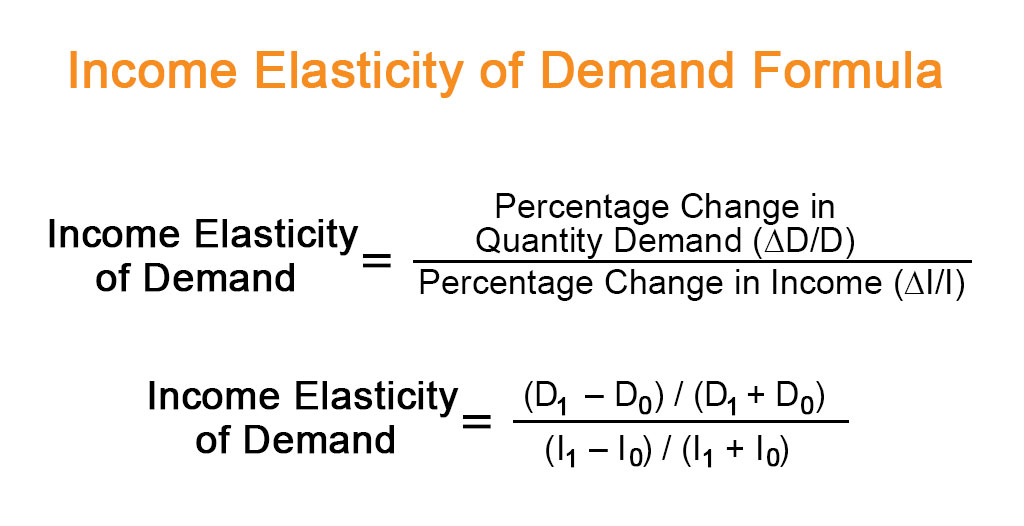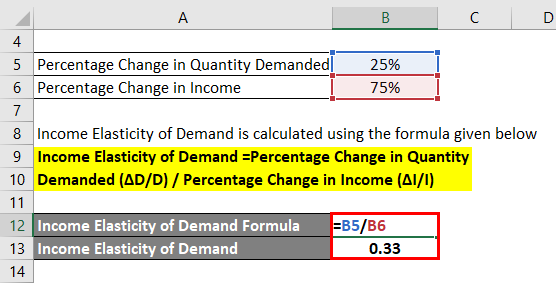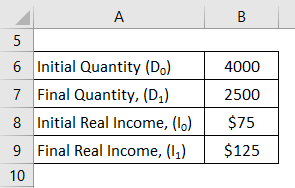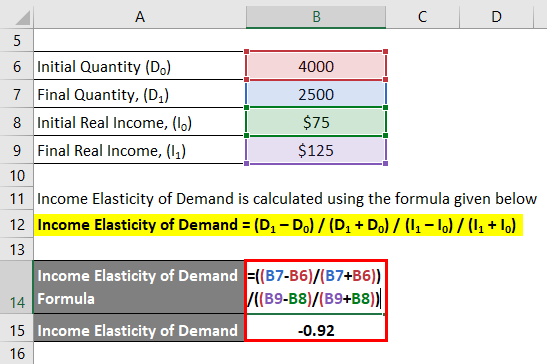Updated July 26, 2023

Income Elasticity of Demand Formula (Table of Contents)
What is the Income Elasticity of Demand Formula?
The term “income elasticity” shows how the demand for certain goods changes with the consumer’s real income. In other words, it measures the responsiveness of the demand for the good to changes in real income.
The formula for income elasticity of demand can be derived by dividing the percentage change in quantity demanded of the good (∆D/D) by the percentage change in real income of the consumer who buys it (∆I/I). The mathematical representation of the formula is:
However, one can further expand the formula for income elasticity of demand as follows.
where,
- D0 = Initial Quantity Demanded
- D1 = Final Quantity Demanded
- I0 = Initial Real Income
- I1 = Final Real Income
Examples of Income Elasticity of Demand Formula (With Excel Template)
Let’s take an example to understand the calculation of Income Elasticity of Demand in a better manner.
Income Elasticity of Demand Formula – Example #1
Let us take the example of some exotic cuisine. Let us assume that recently the average income level has gone up by 75%, which resulted in extra money and an increase in the consumption of exotic cuisines by 25%. Calculate the income elasticity of demand based on the given information.

Solution:
The formula to calculate the Income Elasticity of Demand is as below:
Income Elasticity of Demand = Percentage Change in Quantity Demanded (∆D/D) / Percentage Change in Income (∆I/I)

- Income Elasticity of Demand = 25% / 75%
- Income Elasticity of Demand = 0.33
Therefore, the income elasticity of demand for exotic cuisine is 0.33, i.e., a normal good.
Income Elasticity of Demand Formula – Example #2
Let us take the example of cheap garments. The weekly demand for cheap garments went down from 4,000 pieces to 2,500 pieces as the level of real income in the economy increased from $75 per day to $125 per day. The reason is the shift in preference due to the availability of extra money on the back of increased income level. Calculate the income elasticity of demand based on the given information.

Solution:
The formula to calculate the Income Elasticity of Demand is as below:
Income Elasticity of Demand = (D1 – D0) / (D1 + D0) / (I1 – I0) / (I1 + I0)

- Income Elasticity of Demand = [(2,500 – 4,000) / (2,500 + 4,000) ] / [($125 – $75) / ($125 + $75)]
- Income Elasticity of Demand = -0.92
Therefore, the income elasticity of demand for cheap garments is -0.92, i.e., an inferior good.
Explanation
The formula for income elasticity of demand can be derived by using the following steps:
Step 1: First, determine the initial real income and quantity demanded at that income level, denoted by I0 and D0, respectively. Similarly, determine the final real income and demand denoted by I1 and D1, respectively.
Step 2: Next, calculate the change in quantity demanded by subtracting the initial quantity from the final quantity. The percentage change in quantity demanded is calculated by dividing the change in quantity demanded by the average of the final and initial quantities i.e. 2 * (D1 – D0) / (D1 + D0).
Step 3: Next, calculate the change in real income by subtracting the initial income from the final income. The percentage change in real income is calculated by dividing the change in real income by the average of the final and initial incomes i.e. 2 * (I1 – I0) / (I1 + I0).
Step 4: Finally, the income elasticity of demand formula can be derived by dividing the percentage change in quantity demanded of the good (step 2) by the percentage change in real income of the consumer who buys it (step 3) as shown below.
Income Elasticity of Demand = (D1 – D0) / (D1 + D0) / (I1 – I0) / (I1 + I0),
Relevance and Uses of Income Elasticity of Demand Formula
Understanding the concept of income elasticity of demand is important because it helps businesses predict the impact of economic cycles on their product sales. Based on the value of the income elasticity of demand, businesses categorize goods into two broad categories – normal goods and inferior goods.
Normal goods exhibit the value of income elasticity of demand of more than zero, indicating that the quantity demanded of normal goods increases with the increase in the level of income. Necessity goods are the type of normal goods whose value of income elasticity of demand lies in the range of zero and one and belong to the group of products and services that are bought regardless of the changes in income levels. On the other hand, luxury goods are normal goods with a value of income elasticity of demand greater than one.
Inferior goods exhibit the value of income elasticity of demand of less than zero, indicating that the quantity demanded of inferior goods decreases with the increase in income because of consumer preference shifts from cheaper products and services to better ones.
Income Elasticity of Demand Formula Calculator
You can use the following Income Elasticity of Demand calculator:
| Percentage Change in Quantity Demanded (∆D/D) | |
| Percentage Change in Income (∆I/I) | |
| Income Elasticity of Demand | |
| Income Elasticity of Demand = |
|
|
Recommended Articles
This is a guide to the Income Elasticity of Demand Formula. Here we discuss how to calculate the Income Elasticity of Demand along with practical examples. We also provide an Income Elasticity of Demand calculator with a downloadable Excel template. You may also look at the following articles to learn more –


